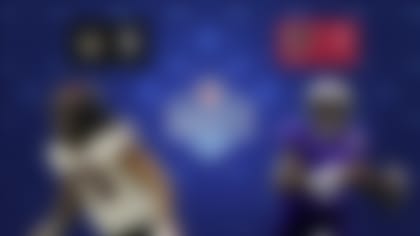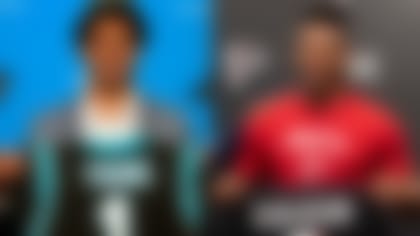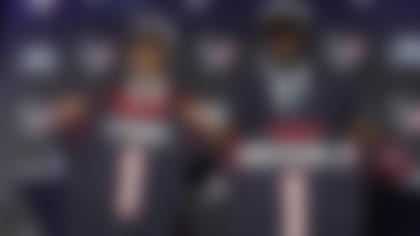NFL.com analyst Bucky Brooks is handing out grades for each team following the 2009 NFL Draft. Check back daily as he breaks down each team, division by division.
After watching the draft come and go, it is time to assess how each team fared in the league's biggest event. From the acquisition of talent to the execution of various draft strategies, teams were graded on their overall ability to play the chess game that emerges on draft weekend.
Let's take a look to see how the teams from the NFC East performed during the 2009 draft:
[
Dallas Cowboys: C-
The Cowboys entered the draft hamstrung by the Roy Williams trade, which left them without first-, third-, and sixth-round picks. Although the transaction resulted in the Cowboys receiving a former Pro Bowler, the surrendering of three potential prospects means the success of Dallas' 2009 draft class will primarily be determined by Williams' performance over the next few seasons.
Without a pick until the second round (No. 51), the Cowboys were expected to grab a highly-rated prospect such as S William Moore or DE/LB Cody Brown that had surprisingly fallen down draft boards, but the team opted to move out of the round by trading their pick to Buffalo. Although the move helped the team secure 12 second-day picks, the decision to bypass a potential impact rookie is a puzzling one to say the least.
The Cowboys did acquire a promising young linebacker when it selected small-school standout Jason Williams in the third round. The Western Illinois product opened eyes with his impressive showing at his pro day, and has a chance to excel on special teams while working into the linebacker rotation.
Stephen McGee, the team's fourth-round selection, gives the Cowboys an intriguing quarterback prospect in the mold of Tony Romo. He had risen up draft boards due to his exceptional athleticism, and is regarded as one of the draft's biggest sleepers at the position.
The Cowboys used the rest of their picks to acquire depth at key positions on defense. The team used six of its nine late-round picks on linebackers and defensive backs in hopes of finding a few hidden gems that emerge as key contributors. The late-round selection with the biggest chance of making an impact is seventh-round pick Mike Mickens. The former Bearcat has good overall skills, but fell down the board due to concerns over a balky knee. If he is able to overcome his injury issue, he could emerge as a quality nickel corner in the Cowboys' scheme.
While the Cowboys moved up and down the board to accumulate a plethora of draft picks, their 2009 draft class contains few players that will actually make their opening-day roster, and makes their host of draft-day activity appear more style than substance.
[
New York Giants: B+
The G-Men wisely adhered to a strategy of taking the best available player on the board, rather than picking for need. The team's shrewd approach netted a draft class that is brimming with future starters at multiple positions.
In the first round, the Giants patiently waited for their No. 1 receiver, Hakeem Nicks, to land in their laps. Though there was some debate about whether the former Tar Heel would make it down to the 29th pick, the Giants were able to get their guy without making a move. For a team that desperately lacked a playmaker in the passing game when Plaxico Burress left the lineup, Nicks is poised to play a significant role as a rookie.
In the second round, the team landed two future starters (Clint Sintim and William Beatty) even though they didn't have a pressing need at either position. The Giants are one of the best teams in the league at developing their own talent, and this is another example of the team proactively addressing a future void well in advance.
Jerry Reese and Co. worked the board to perfection in later rounds to pick up three highly rated prospects (Ramses Barden, Andre Brown and Travis Beckum) in the middle rounds. Each has the potential to contribute immediately, but the one to watch is Barden. The Herculean playmaker from Cal Poly has the size and athleticism to handle some of the red-zone duties that were previously filled by Plaxico Burress.
With a deft mix of patience and shrewd maneuvering, the Giants upgraded a roster that rates among the league's best on paper.
[
The Eagles had ample ammunition to implement an aggressive draft-day strategy with two first-round picks. Andy Reid parlayed those options into a terrific draft class. Prior to the draft, Reid acquired a two-time Pro Bowler (Jason Peters) for the second of their first-round picks, which is a terrific return for a late first-round choice.
In addition, the Eagles moved up in the first round to get an explosive playmaker (Jeremy Maclin) few expected to see fall out of the top 10. Maclin teams with DeSean Jackson to give Donovan McNabb two weapons to utilize in the Eagles' short passing game.
The Eagles' retooling of their offense continued in the second round with their selection of LeSean McCoy. The former Panther possesses running skills eerily similar to two-time Pro Bowler Brian Westbrook, and he gives the team another weapon as a potential third-down specialist.
With six picks in the draft's last three rounds, the Eagles had the luxury of taking a chance on Cornelius Ingram. The former Gator missed all of 2008 with an ACL injury, but could emerge as a much-needed threat in the middle of the field, if he has fully recovered from his injury.
The team also addressed a weakness in its secondary by acquiring veteran corner Ellis Hobbs in a trade with the Patriots for two fifth-round picks. Hobbs serves as insurance against a possible Sheldon Brown holdout during training camp.
[
The Redskins avoided, or were shut out, in the Mark Sanchez sweepstakes, but the lack of activity worked in their favor as they landed a top pass rusher in Brian Orakpo. The former Longhorn was universally regarded as a top-10 talent, but landed with the Redskins at the 13th pick. Orakpo fills their biggest need and the Redskins didn't have to mortgage the future to stabilize the situation.
The Redskins used the draft's second day to upgrade their depth at several positions. Kevin Barnes gives the team an athletic corner with ideal size and movement skills. As a potential third or fourth corner, he is a value pick in the third round.
The team picked up a pair of potential special teamers in Cody Glenn and Robert Henson in the later rounds. Although they aren't household names, the duo's ability to contribute in some capacity will eventually make or break the Redskins' draft class.
The Redskins eschewed their normal free-wheeling ways to assemble a solid crew of players, and they deserve credit for standing pat and picking good players with their respective selections.












